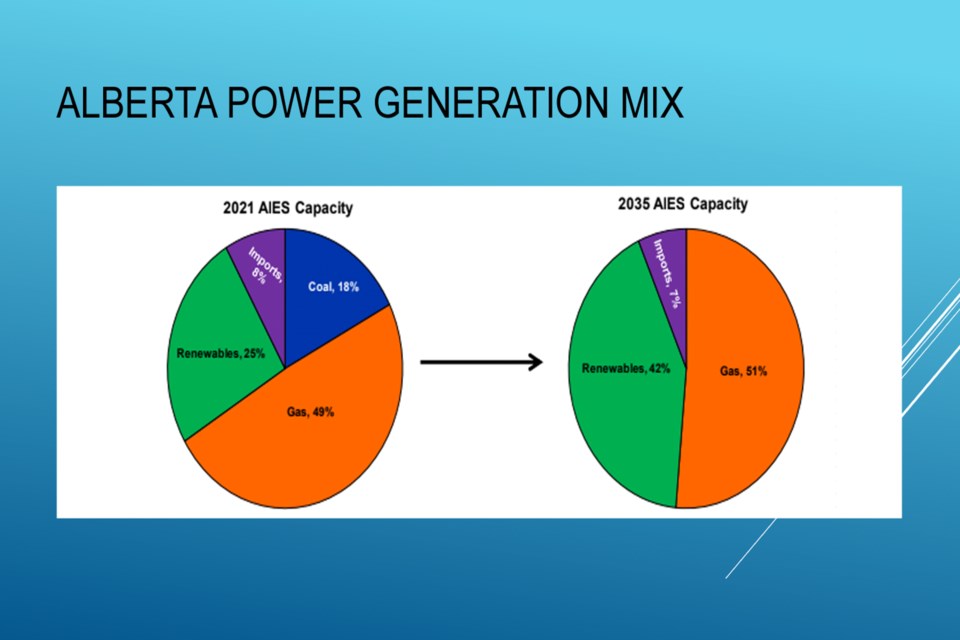ATHABASCA – Athabasca County has given the go-ahead to start a grant application that will potentially pay for 80 per cent of a proposed $1.53 million solar energy project for the Athabasca Regional Multiplex.
Councillors passed a motion at their March 31 meeting to proceed with SkyFire Energy, which was recommended by Regional Municipal Climate Action Committee (RMCAC) members to install a 1,173 kWdc photo voltaic solar energy system on the rooftops of the buildings that make up the Multiplex facility, provided an application to the federal Green and Inclusive Community Buildings (GICB) program, through Infrastructure Canada, is successful.
Municipal energy manager Kevin Jacobs was joined by RMCAC members Dr. Mike Gismondi and Steve Sulz to go over some of the finer details of the potential project. RMCAC is a consortium of the three Athabasca-area municipalities and public members set up to explore and recommend future energy efficiency options and opportunities under the umbrella of the provincial Municipal Climate Change Action Centre (MCCAC).
With 80 per cent of the costs being covered through GICB, Jacobs told council the county, along with its partner in the Town of Athabasca would pay a combined $292,216 plus GST to cover the remaining cost of the system.
“There's $860 million available until March 2026,” Jacobs said. “It sounds like the program has been pretty heavily subscribed to, and it is not first-come-first-served. They are looking at the best projects and I think because we’re a rural community in Western Canada and this is a huge energy reduction … it would probably have a good chance.”
Using numbers from the last complete year before the pandemic, Jacobs noted 2,370,239 kWh was used by the facility between April 2019 and March 2020. At the current energy rates, electricity alone would cost $163,433 per year. With a new electricity contract just signed, the Multiplex is locked in, but by the time that contract expires in 2027, the rate at which carbon is taxed will have changed drastically, and assuming all other variables remain the same, which is unlikely, electricity for facility will cost an additional $94,000, making the transition to a renewable energy source a very good option, especially if the majority is covered through grants, he said.
Alberta’s power mix is expected to shift away from coal in the next 15 years with renewables accounting for a full 42 per cent of the provincial power used.
The system proposed by SkyFire, includes 2,172 modules and six roof-mounted converters. Ballasted racking at a 10-degree angle would be used on the roof of the pool, while the rest would be installed using standing seam, flush-mounted racking on the metal roofs.
To qualify for the GICB program, total energy consumption by the facility must be reduced by at least 10 per cent, but up to 25 per cent is recommended. The recommended system will reduce total energy consumption by 13.1 per cent, while total electrical consumption will fall by 42 per cent.
It would produce 996,400 kW per year over the first 25 years. After that, production may trend downward, but 80 per cent of the full production would continue throughout the remainder of their useful lives. The warranty is valid for 30 years, he added
“So, a million kilowatt hours per year is about 182 homes worth of electricity use; 1,635 barrels of oil per year; or 9.3 tanker trucks; or 86 million cell phone chargers and saves the same amount of carbon sequestered by 865 acres of forests per year,” Jacobs said to provide some perspective.
With the GICB, the expected time to pay off the project is 4.2 years, he added, and without it, it could still be paid off in 21 years, well before the life expectancy of the system arrives.
To close, Jacobs gave two recent and nearby examples of successful solar installations at Edwin Parr Composite School and the Rotary Spirit Centre in Westlock.
The school’s rooftop system was included when the new school was built in 2018, and according to numbers from the two years following has saved Aspen View Public Schools $53,000 in energy costs.
The 292 kW system offsets 278,519 kWh per year and provides for about a third of the school’s annual energy consumption.
In Westlock, the town opted for a 625 kW system, worth $1.184 million, on the Rotary Spirit Centre in 2019, which has been outperforming expectations since it was installed. It offsets 575,866 kW per year and is expected to save $55,000 per year in energy costs with an estimated simple payback of just over 12 years. In its first year, the town saw more than $62,000 in savings. The town paid for 43 per cent of the project with the remainder coming through a MCCAC agreement. The array covers 31 per cent of that facility’s annual electrical consumption.



